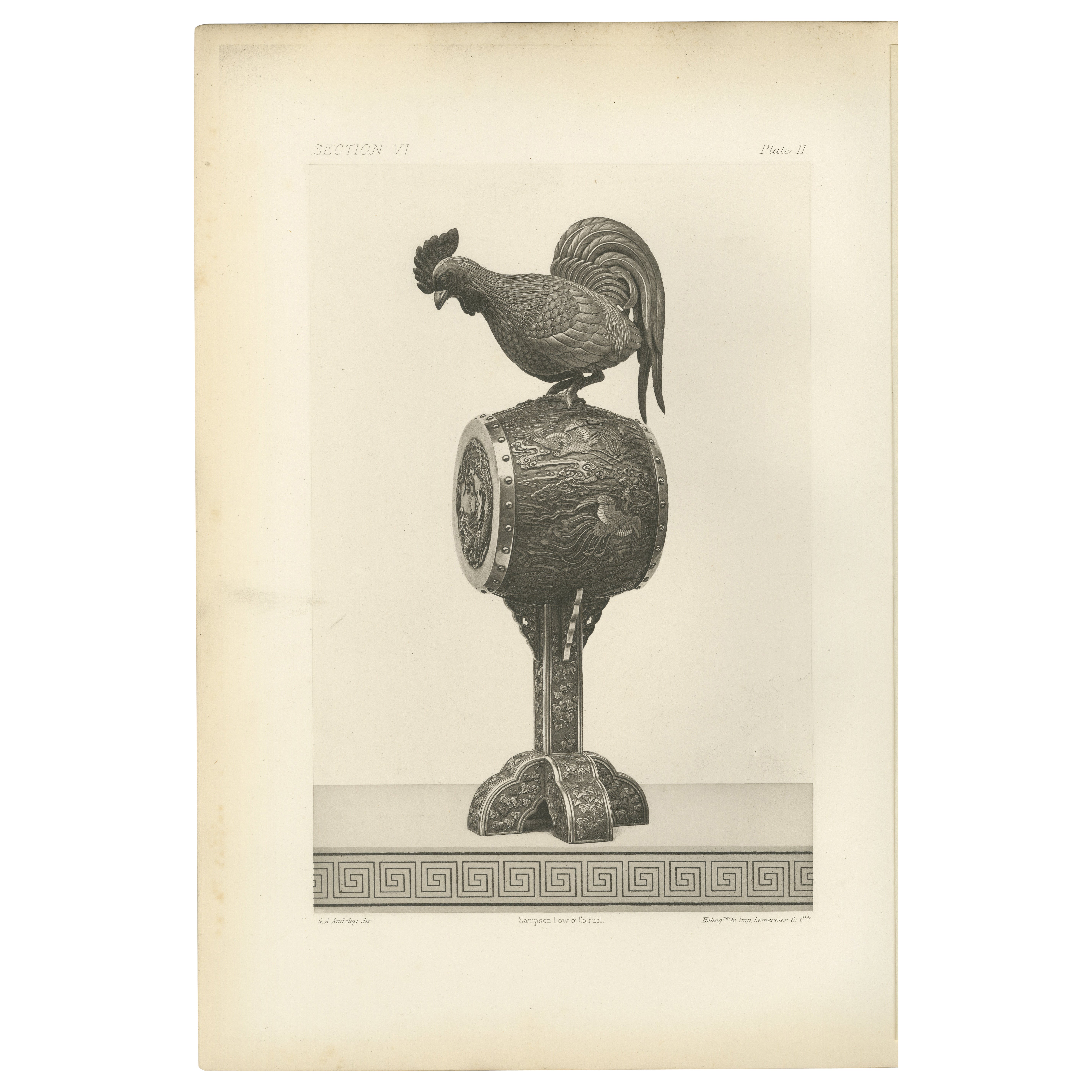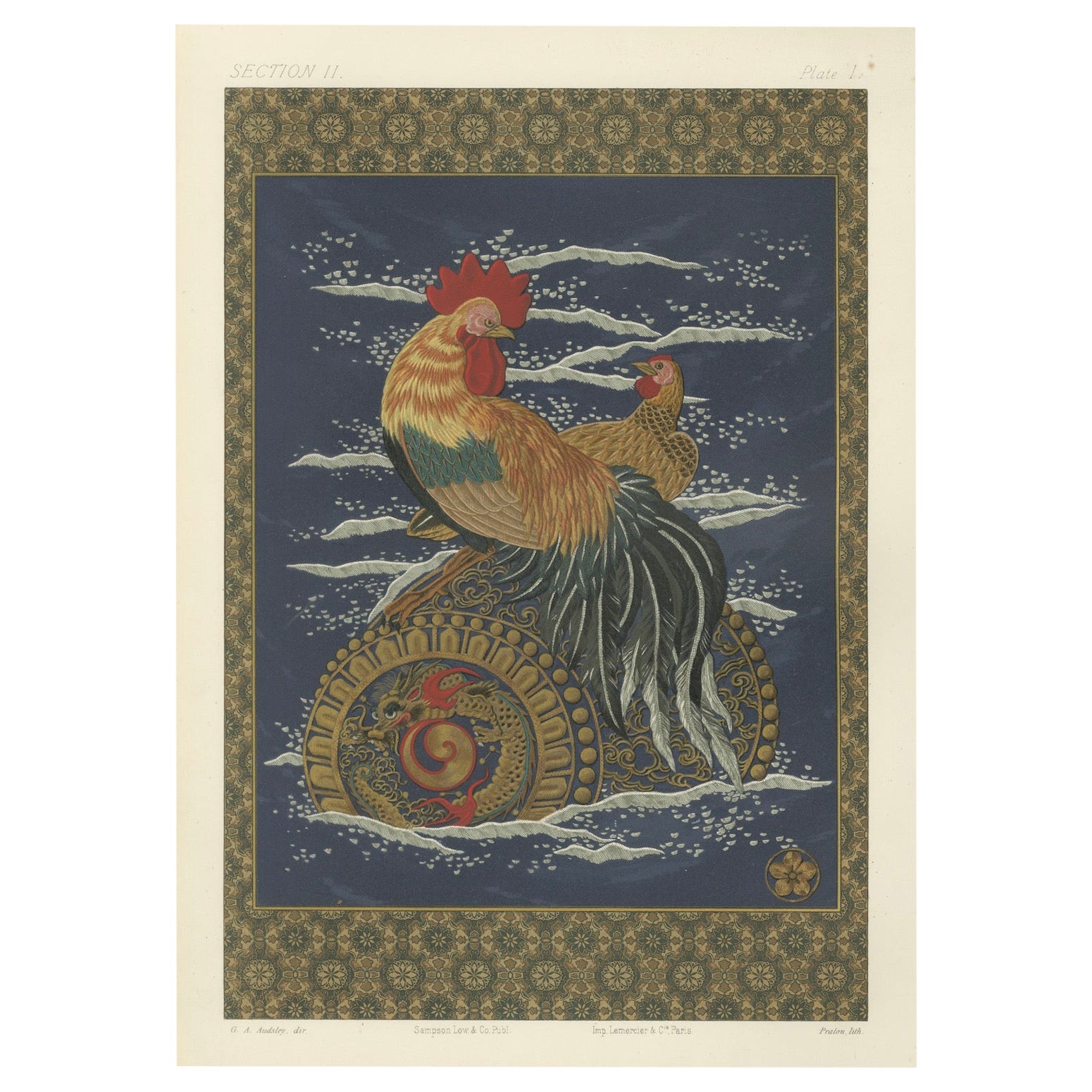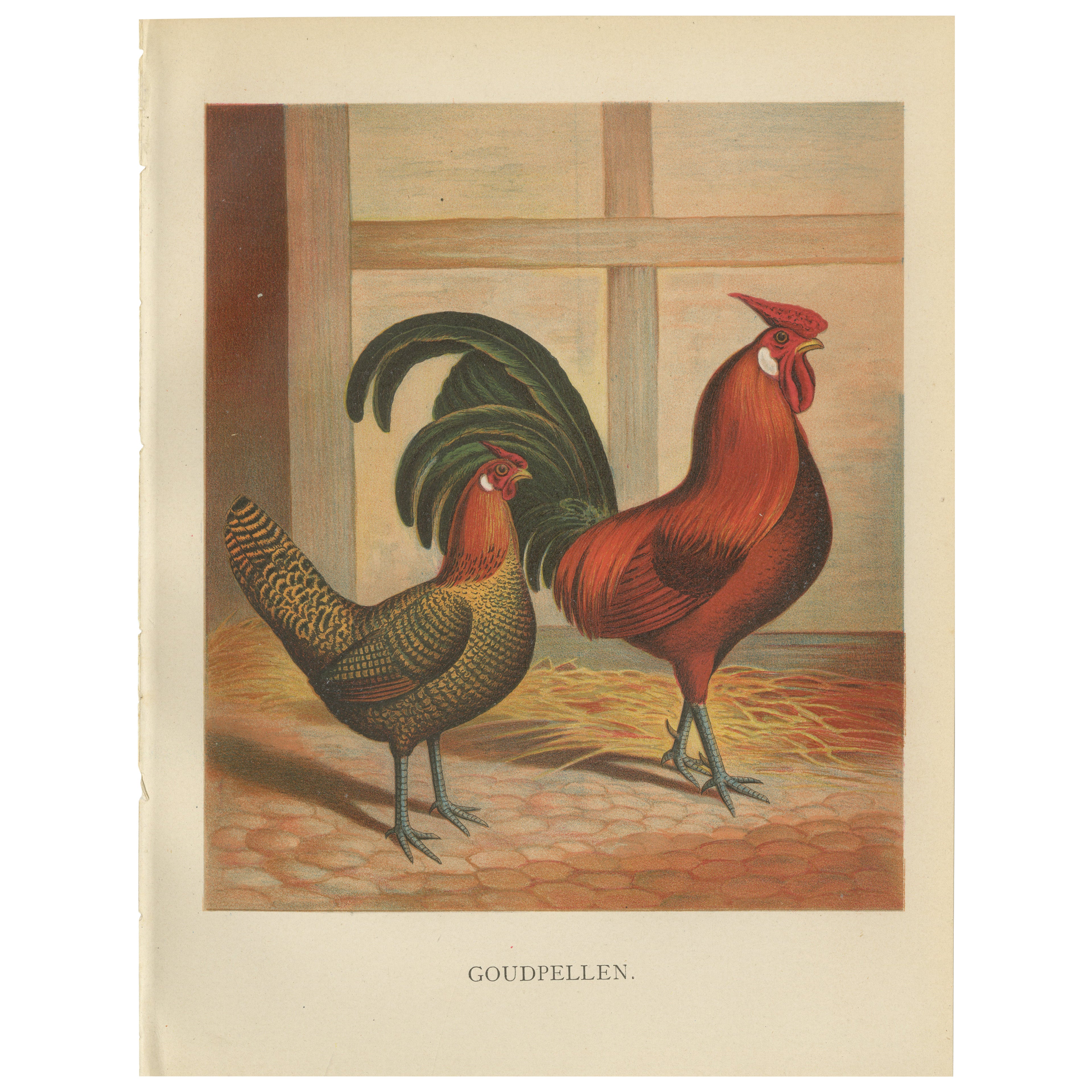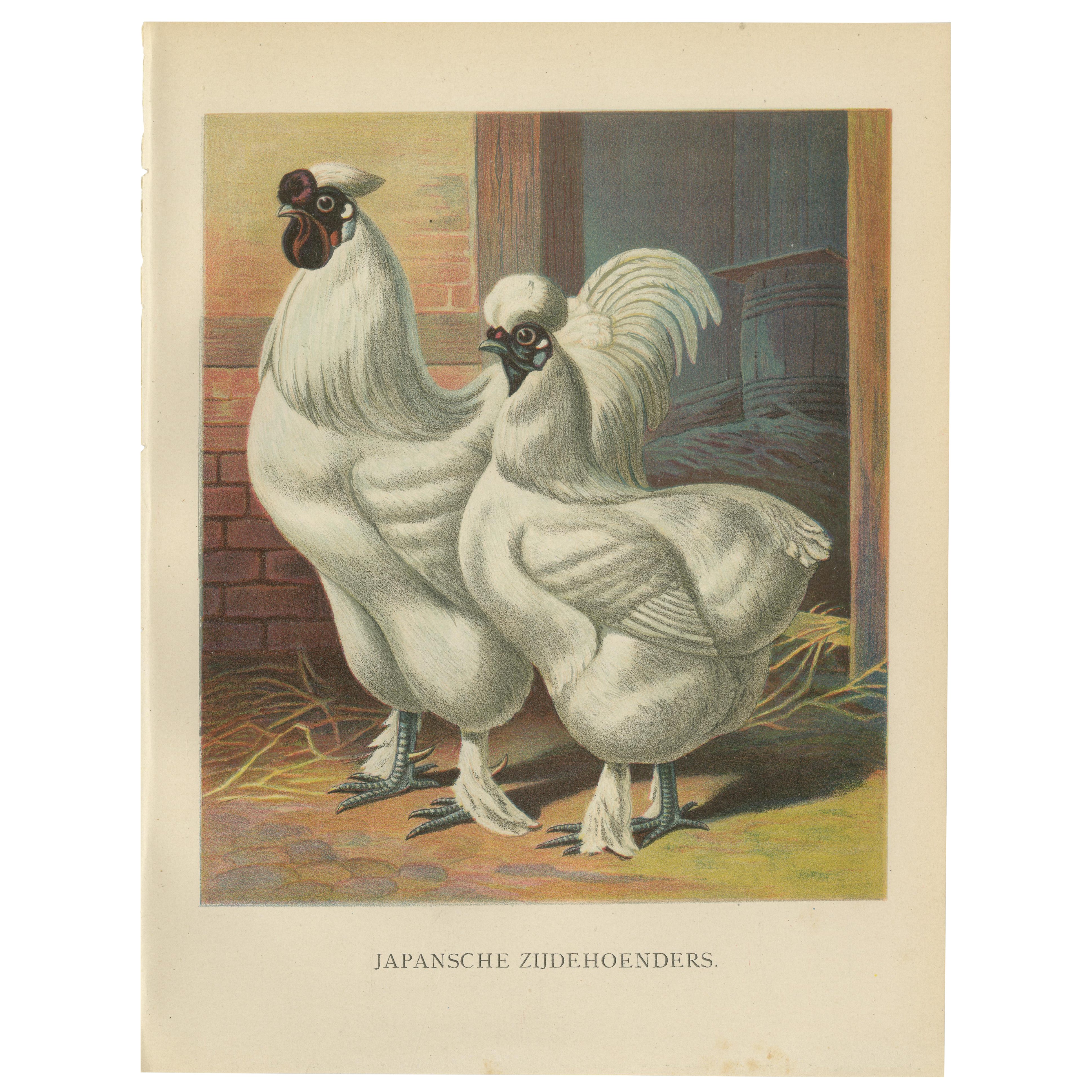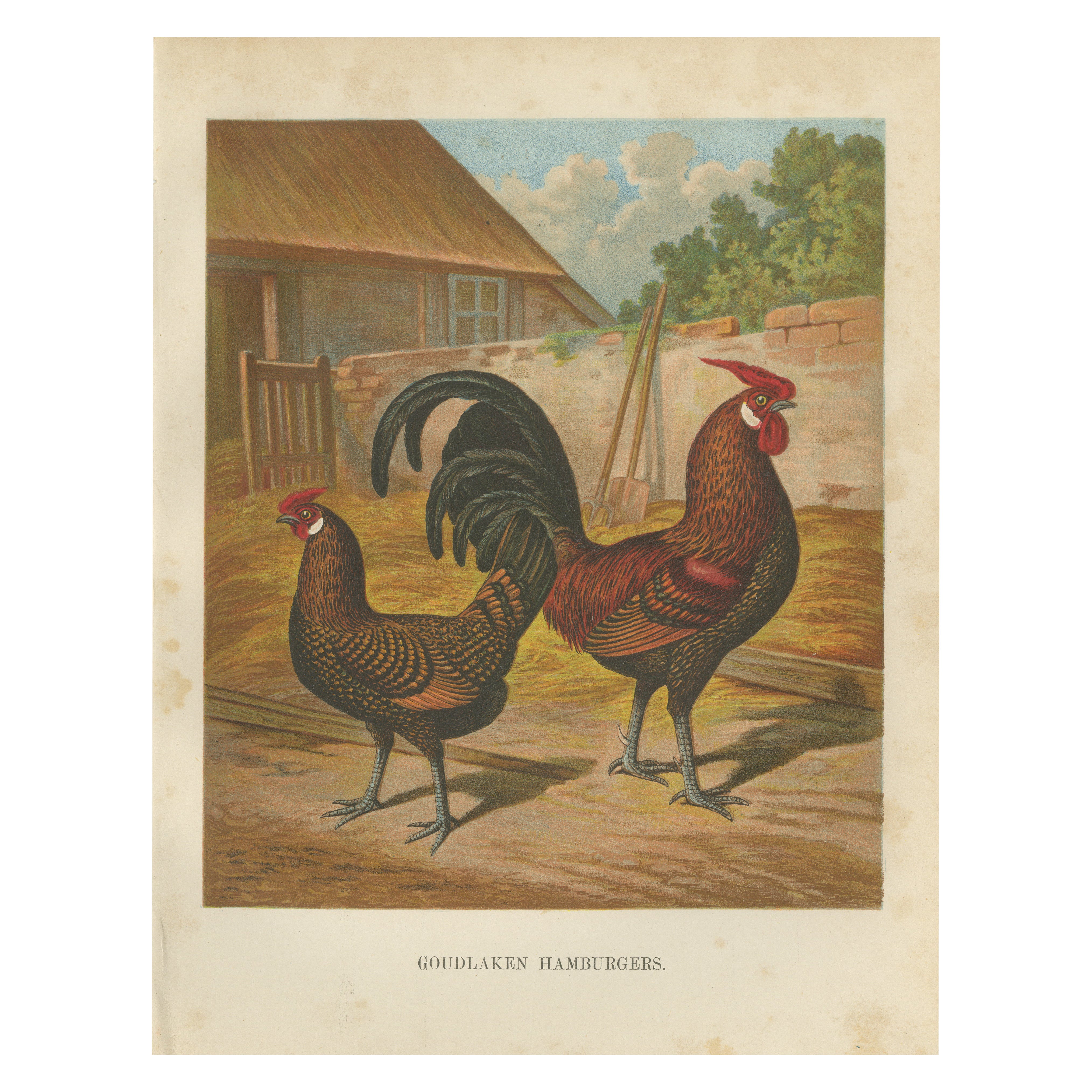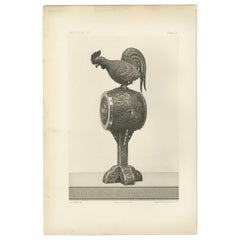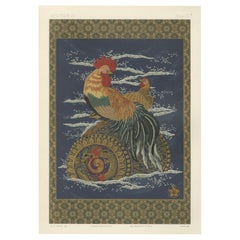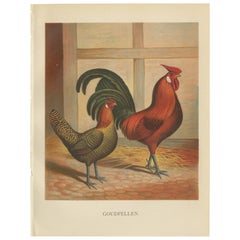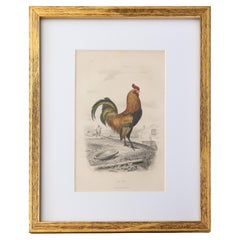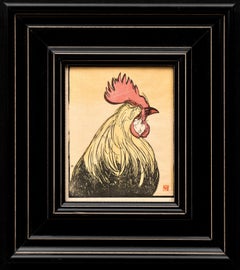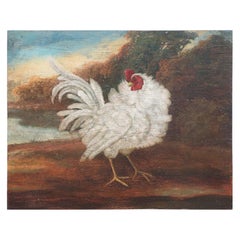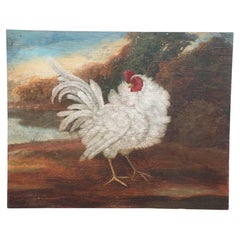Items Similar to Japanese Rooster Drum Stand: Antique Lithograph, 1880s
Want more images or videos?
Request additional images or videos from the seller
1 of 11
Japanese Rooster Drum Stand: Antique Lithograph, 1880s
$347.46
£258.61
€290
CA$475.94
A$529.34
CHF 276.41
MX$6,441.56
NOK 3,530.14
SEK 3,310.65
DKK 2,207.67
Shipping
Retrieving quote...The 1stDibs Promise:
Authenticity Guarantee,
Money-Back Guarantee,
24-Hour Cancellation
About the Item
Title: Japanese Rooster Drum Stand: Antique Lithograph, 1880s
Description:
This detailed lithograph from the 1880s features an exquisite depiction of a traditional Japanese drum stand, elegantly topped with a carved rooster figure. Published by Sampson Low & Co. and printed in Paris by the skilled craftsmen at Imp. Lemercier & Cie, this piece was directed by G. A. Audsley, a noted British artist celebrated for his fascination with Japanese decorative arts.
The rooster, beautifully rendered in naturalistic tones of red, brown, and gold, perches regally atop a richly ornamented wooden drum. Its meticulously detailed feathers and lifelike stance convey a sense of proud vigilance—a symbol of dawn and new beginnings in Japanese tradition. Beneath the rooster, the drum itself is decorated with delicate vine and grape motifs, meticulously shaded to create a tactile, three-dimensional appearance. The effect is a stunning interplay of naturalism and craftsmanship, hallmarks of Meiji-era design.
The entire composition is further enriched by the careful shading and textural details achieved through the lithographic process, capturing both the elegance of the wooden grain and the refined floral patterns. The subdued backdrop in muted green highlights the golden browns and deep reds, creating a harmonious and timeless piece of art.
This lithograph is a beautiful testament to the Japonisme movement that swept through Europe in the late 19th century, offering a glimpse into the refined artistry and cultural symbolism of Japanese decorative arts. It would make a superb addition to any collection of Japanese art, antique prints, or as a sophisticated centerpiece for those who appreciate the quiet beauty of traditional craft.
Condition report:
Excellent condition, with minor foxing and light age-related spots at the edges typical for prints of this era. The colors remain vibrant, and the intricate details are superbly preserved.
Framing tips:
Frame this lithograph in a simple black or dark wood frame to ground the warm natural tones and highlight the rooster’s striking form. A soft cream or warm beige mat will provide an elegant contrast, allowing the rich textures and refined artistry of the piece to shine.
- Dimensions:Height: 15.75 in (40 cm)Width: 10.83 in (27.5 cm)Depth: 0.01 in (0.2 mm)
- Materials and Techniques:
- Period:
- Date of Manufacture:circa 1882
- Condition:Excellent condition, with minor foxing and light age-related spots at the edges typical for prints of this era. The colors remain vibrant, and the intricate details are superbly preserved.
- Seller Location:Langweer, NL
- Reference Number:Seller: BG-14034-1-491stDibs: LU3054345275592
About the Seller
5.0
Recognized Seller
These prestigious sellers are industry leaders and represent the highest echelon for item quality and design.
Platinum Seller
Premium sellers with a 4.7+ rating and 24-hour response times
Established in 2009
1stDibs seller since 2017
2,508 sales on 1stDibs
Typical response time: <1 hour
- ShippingRetrieving quote...Shipping from: Langweer, Netherlands
- Return Policy
Authenticity Guarantee
In the unlikely event there’s an issue with an item’s authenticity, contact us within 1 year for a full refund. DetailsMoney-Back Guarantee
If your item is not as described, is damaged in transit, or does not arrive, contact us within 7 days for a full refund. Details24-Hour Cancellation
You have a 24-hour grace period in which to reconsider your purchase, with no questions asked.Vetted Professional Sellers
Our world-class sellers must adhere to strict standards for service and quality, maintaining the integrity of our listings.Price-Match Guarantee
If you find that a seller listed the same item for a lower price elsewhere, we’ll match it.Trusted Global Delivery
Our best-in-class carrier network provides specialized shipping options worldwide, including custom delivery.More From This Seller
View AllRooster on an Ornamental Drum – from Audsley’s Decorative Masterpieces, 1884
Located in Langweer, NL
Title: Rooster on an Ornamental Drum – Plate II from Section VI of G. A. Audsley’s Decorative Masterpieces
Description: This remarkable chromolithograph, Plate II from Section VI of...
Category
Antique 1880s Prints
Materials
Paper
Antique Japanese Rooster and Hen Print: Symbolic Beauty, 19th Century
Located in Langweer, NL
Antique Japanese Rooster and Hen Print: Symbolic Beauty, 19th Century
This vibrant 19th-century Japanese print beautifully captures a proud rooster a...
Category
Antique 1880s Prints
Materials
Paper
The Majestic Golden Penciled Chicken - A Rare 19th Century Poultry Lithograph
Located in Langweer, NL
The Majestic Golden Penciled Chicken A Rare 19th Century Poultry Lithograph
This exquisite 19th century chromolithograph features a pair of Golden Penciled chickens, a breed known for its striking feather pattern, refined body shape, and graceful presence. The print, titled Goudpellen, originates from Geïllustreerd Hoenderboek, an Illustrated Poultry Book published in 1888 by Elsevier. Compiled by Julius Volschau and adapted for Dutch readers by Dr. A. C. Oudemans Jzn., this book provided detailed insights into poultry breeding, showcasing both practical and ornamental breeds that were highly valued in the 19th century.
The Golden Penciled variety is known for its intricate feather markings, especially in the hens, which display an elegant gold and black penciling pattern across their bodies. The roosters are equally impressive, with a rich golden-red hue, an upright stance, and a gracefully arched tail. This breed was admired not only for its aesthetic appeal but also for its active and hardy nature, making it a popular choice among poultry enthusiasts in the 19th century.
This lithograph was created using chromolithography, a sophisticated 19th century printing technique that allowed for vibrantly detailed and richly colored illustrations. The artwork is based on an original drawing by Christian Förster, a skilled animal illustrator of the time. Chromolithographs were produced by layering multiple colors, each applied with a separate stone plate, ensuring depth and realism in the final print. The precision in rendering the feather texture and vibrant golden tones in this lithograph highlights the artistry involved in this technique.
Condition Summary
The print remains in very good condition, with well preserved colors and sharp details. Some minor age related toning and light foxing spots are visible, particularly along the edges, which is common in lithographs of this period. The paper remains stable, with minimal signs of wear, making this an excellent collectible piece for antique poultry print...
Category
Antique 1880s Prints
Materials
Paper
The Regal Partridge Italian Chicken - A Rare 19th Century Poultry Lithograph
Located in Langweer, NL
The Regal Partridge Italian Chicken A Rare 19th Century Poultry Lithograph
This remarkable 19th century chromolithograph features a pair of Partridge Italian chickens, a breed admired for its striking plumage, graceful build, and lively temperament. The print, titled Patrijsveer-Italianen, originates from Geïllustreerd Hoenderboek, an Illustrated Poultry Book published in 1888 by Elsevier. Compiled by Julius Volschau and adapted for Dutch readers by Dr. A. C. Oudemans Jzn., this book provided an extensive guide to poultry breeding, detailing both functional and ornamental breeds highly regarded in the 19th century.
Partridge Italian chickens are a visually striking variety, displaying a rich combination of deep golden-brown, black, and chestnut hues. The rooster in this lithograph stands with an imposing posture, exhibiting its glossy black tail feathers and vibrant golden saddle feathers. The hens are equally beautiful, featuring finely patterned feathering on their backs and wings, transitioning into a warm golden-brown on their chests. This variety is not only known for its beauty but also for its excellent egg-laying abilities and hardy nature, making it a favorite among poultry breeders.
This lithograph was created using chromolithography, a highly skilled 19th-century printing process that allowed for vibrant, multi-colored illustrations. The artwork is based on an original drawing by Christian Förster, a well-known animal illustrator of the time. Chromolithography involved layering multiple colors, each applied with a separate stone plate, to achieve depth, shading, and fine detail. The precision in rendering the intricate feather textures and the interplay of light and shadow in this lithograph highlights the mastery of this technique.
Condition Summary
The print remains in very good condition, with its colors still rich and vibrant. Some minor age-related toning and light foxing are visible along the edges, a common characteristic of lithographs from this period. The paper is stable with minimal signs of wear, making it a valuable collectible for antique poultry print...
Category
Antique 1880s Prints
Materials
Paper
The Enchanting Japanese Silkie Chicken - A Rare 19th Century Poultry Lithograph
Located in Langweer, NL
The Enchanting Japanese Silkie Chicken A Rare 19th Century Poultry Lithograph
This exquisite 19th-century chromolithograph showcases a pair of Japanese Silkie chickens, a breed kn...
Category
Antique 1880s Prints
Materials
Paper
The Elegant Golden Spangled Hamburg Chicken - A 19th Century Poultry Lithograph
Located in Langweer, NL
The Elegant Golden Spangled Hamburg Chicken A Rare 19th Century Poultry Lithograph
This exquisite 19th century chromolithograph features a pair of Golden Spangled Hamburg chickens, an elegant and highly regarded breed known for its striking plumage, graceful build, and excellent egg laying capabilities. The print, titled Goudlaken Hamburgers, originates from Geïllustreerd Hoenderboek, an Illustrated Poultry Book published in 1888 by Elsevier. Compiled by Julius Volschau and adapted for Dutch readers by Dr. A. C. Oudemans Jzn., this book provided a comprehensive guide to poultry breeding, highlighting both practical and ornamental breeds that were highly valued in the 19th century.
Hamburg chickens are one of the oldest known domesticated poultry breeds, with records tracing them back to at least the 14th century. They were particularly popular in the Netherlands, Germany, and England due to their striking feather patterns and exceptional egg laying abilities. The Golden Spangled Hamburg, as depicted in this lithograph, is a particularly eye catching variety, featuring a rich golden brown base color accented with bold black spangling. The rooster stands tall with its flowing tail feathers and proud posture, while the hen, slightly smaller, displays the same intricate feather pattern in a more compact form.
This lithograph was created using chromolithography, a meticulous 19th century printing technique that allowed for vibrant and finely detailed illustrations. The artwork is based on an original drawing by Christian Förster, a skilled animal illustrator of the time. Chromolithographs were produced by layering multiple colors, each applied with a separate stone plate, ensuring depth and realism in the final print. The detailed feather patterning and the warm golden hues in this print highlight the craftsmanship involved in this artistic technique.
Condition Summary
The print remains in good condition, with well preserved colors and sharp details. Some minor age related toning and visible foxing spots are present along the edges, which is common in lithographs of this period. The paper remains stable, with slight signs of wear, making this an excellent collectible piece for antique poultry print...
Category
Antique 1880s Prints
Materials
Paper
You May Also Like
Custom Framed Antique Rooster Engraving
By Georges-Louis Leclerc, Comte de Buffon
Located in Pearland, TX
Georges-Louis Leclerc, Count of Buffon (1707-1788) was a French naturalist, mathematician, and cosmologist. Buffon published thirty-six quarto volumes of his most well-known work, Hi...
Category
Antique 1850s French Decorative Art
Materials
Other
Antique Rooster Woodblock Print circa 1910 by Prosper Alphonse Isaac
Located in SANTA FE, NM
Antique Rooster Portrait
Prosper Alphonse Isaac (France, 1858-1924)
Woodblock Print circa 1910
9 x 7 1/8 (15 1/4 x 17 frame) inches
The excellent book "The Great Wave: The Influence of Japanese Woodcuts on French Prints" which was an exhibition at The Metropolitan Museum of Art in 1974, recounts the phenomenal "cult of Japan" in late nineteenth-century France and reveals through direct comparisons its particular impact on the graphic work of Manet, Degas, Cassatt, Bonnard, Vuillard, Toulouse-Lautrec, and Gauguin. This print directly relates to the discovery of Japanese art most notably through the woodblock prints which found their way to the West oftentimes as stuffing or packing materials from consumer goods that were being imported to the West at the end of the 19th century.
Prosper-Alphonse Isaac was born in a well-to-do family. This gave him the means not only of leaving his native Calais to pursue a career as an artist in Paris, but also the means to acquire art. Isaac was particularly drawn to Japanese arts, which he collected avidly. Many of the objects he bought were eventually given to museums. As a printmaker Isaac started drawing seascapes in dry point, but eventually moved on to become one of only a handful of artists versed in color woodcut techniques in France. His compositions, generally small in scale, are heavily influenced by the arts of Japan. He printed small editions of these works. Aside from this artistic activity, Isaac was also an active textile decorator.
"This mark, which he borrows from Hokusaï and Totoya Hokkeï...
Category
1910s Art Nouveau Animal Prints
Materials
Ink, Laid Paper
Rooster in Nature Print on Wood
Located in Queens, NY
English Victorian style (20th Century) print of a rooster standing on red clay and looking to the side, in front of a blue pond and autumnal trees, on...
Category
20th Century American Mid-Century Modern Paintings
Materials
Wood
Rooster in Nature Print on Wood
Located in Queens, NY
English Victorian style (20th Century) print of a rooster standing on red clay and looking to the side, in front of a blue pond and autumnal trees, on...
Category
20th Century American Mid-Century Modern Paintings
Materials
Wood
French Mid-19th Century Coq, Rooster
Located in Round Top, TX
A very handsome mid-19th century Coq - Rooster from the South of France. Beautifully crafted in zinc with fabulous patina. Now resting on its iron base. A terrific accent piece.
Category
Antique Mid-19th Century French Architectural Elements
Materials
Zinc
Japanese Meiji Period Shibayama Charger Featuring Cockerel
Located in Norwood, NJ
19th century Meiji period charger/plate with cockerel beautifully realistic in layers of carved shell, mother of pearl and bone to stand in high r...
Category
Antique Late 19th Century Japanese Japonisme Decorative Art
Materials
Shell, Bone, Mother-of-Pearl, Lacquer
More Ways To Browse
Japanese Rooster
Japanese Drum
Danish Rosewood Bedside
Daum Crystal Animals
Demi Lune Commode
Dragon Shelves
Ear Of Corn
Edo Charger
Erik Hoglund Glass Sculpture
Federal Secretary
Figural Perfume Bottle
Fish Statues
Flame Mahogany Secretary
Flat File Storage
Foo Dog Jar
Fornasetti Frame
Franco Albini Bar Cart
Frank Lloyd Wright Stained Glass
